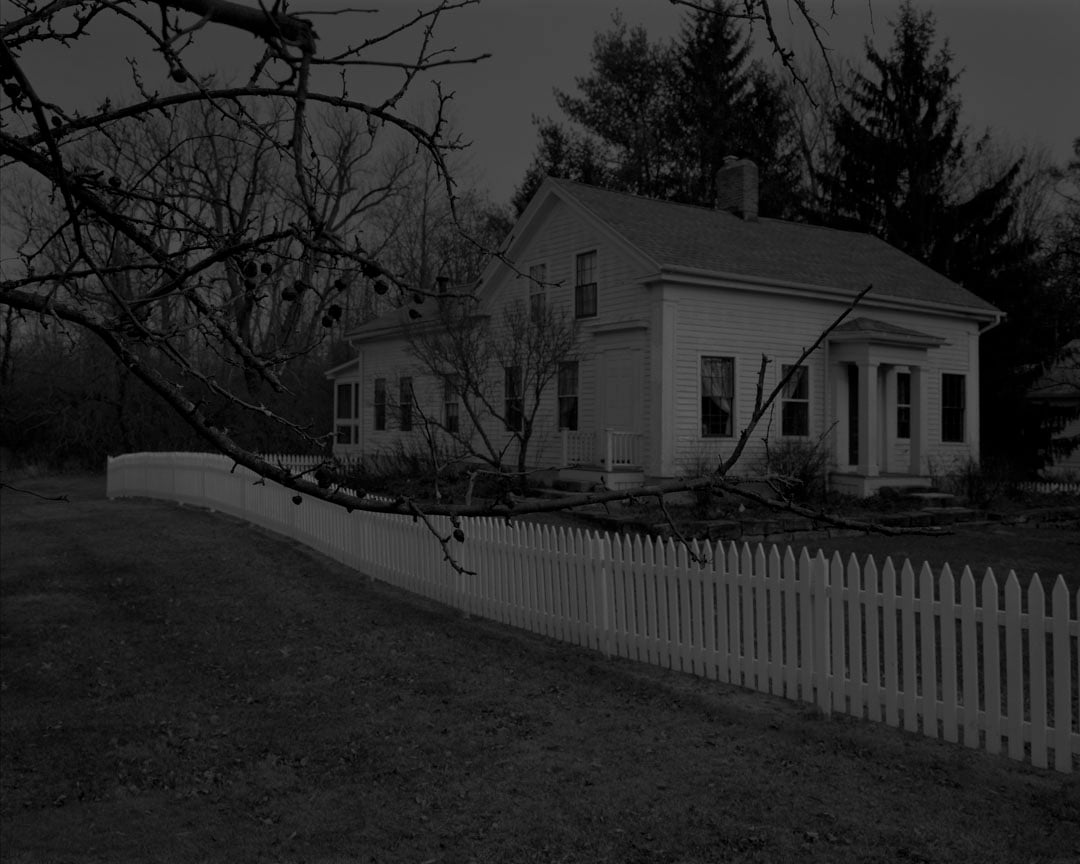
All landscapes are haunted, but some brood more than others. In his solo exhibition, Elegy, at the Virginia Museum of Fine Arts, the Dawoud Bey addresses three interconnected places in Virginia, Louisiana, and Ohio, all of them bound together by traces of enslavement. The artist insists that this is not a project of journalism, in which photography’s task is documentation. As the curator of the exhibition Valerie Cassel Oliver notes in her catalog essay, the genre of landscape resists narrative, and instead, tends more towards poetry. To underscore this notion, Bey’s series Night Coming Tenderly, Black (2017) comes from a line in the poem, “Dream Variations” by Langston Hughes.
The exhibition begins with Stony the Road (2023), a series of twelve large black and white gelatin silver prints that depict an overgrown trail. All images are bereft of people. They are mostly dark, woods thick and clotted with bramble and vine. Despite the density, one can make out a path that leads towards a spot of relative illumination. The room of photographs depicts the Richmond Slave Trail, which was often the first experience of land for Africans who had been captured, shipped across the Atlantic, and then walked from the James River to the auction block in Shockoe Bottom.
From the first gallery one can hear the soundtrack of a two-channel video installation, 350,000 (2023), a haunting movement through the same trail. Watching this space unfold in time shifts the monumental distance of the photographs and pulls one into the space, making the camera a surrogate for the viewers’ bodies. There is the staccato of a horse’s hooves and the jangling of chains, auditory ghosts of human and animal absence.

While aesthetically quite different, I thought of Here and Elsewhere (Ici et Ailleurs), the 1976 film essay by Jean-Luc Godard and Anne-Marie Miéville that cuts between images of a middle-class family in Paris watching TV at home and Palestinian fighters in Jordan, just before Black September. The film sets up a contrast between what is depicted, what is experienced, and the inevitable distance that film produces between a subject and its representation. While watching Bey’s film about the 350,000 enslaved people that walked through this trail, I was aware of the space between presence and absence, between the memory that was invoked and the horrors that lie buried in history. I live in Richmond, and regularly walk trails like the one that Bey depicted, and while I can never forget what it means to live in the former capital of the confederacy, the abject violence of those times is as muted as trees covered in kudzu.
Yet, Bey’s exhibition insistently depicts sites of violence, not only in Richmond, but also a plantation in Louisiana, and the Underground Railroad in Ohio. The latter depictions constitute Night Coming Tenderly, Black (2017), and are indeed, almost black. They are as dark as a moonless night, holding paradoxes between subtle shifts in tone. The cover of shadow could hide an escape, but it also signifies the mourning embedded in a site that was used for liberation.

There’s a moment in the 1959 film Hiroshima mon amour, when a man says, “You have seen nothing in Hiroshima.” It’s a voiceover from the central character, a Japanese architect, presumably speaking to a visiting French actress that has been the focus of a brief love affair. He is from Hiroshima and his family died in the bombing. He proclaims her inability to see anything after the film depicts the city’s devastation, hospitals brimming with bodies that are scarred and burned. But despite these images, the statement implies that while witnessing is an important aspect of memorialization, we must never assume that we have experienced the horror itself. The core of that which must be remembered always resists depiction.
Somehow, the darkness of Bey’s photographs embodies this for me. They hover at the edge of legibility, hiding not only an image, but also what they may signify. Bey himself was deeply impacted at the age of eleven by seeing a photo of Sarah Collins, a 12-year-old survivor of the 1963 firebombing of church in Birmingham, AL, but he has chosen to memorialize tragedy through oblique references rather than direct description.
The historian Imani Perry, who contributed to the exhibition catalog, notes, “History, like the waters, is arterial. The past pumps itself into our bloodstreams.” Water is ever present in the exhibition. In his 2023 work Untitled (James River Through the Opening) the flowing body of water is centered in the landscape. In his 2019 work Mississippi River and Trees, water is a multiplier, doubling a line of saplings across a horizontal axis through a reflection. Buried in these images is a history of cities that grow from the water that runs through them. Perry’s metaphor ties these rivers to our bodies and to the shared social body. History is a force that moves through us and the work of Dawoud Bey reminds us to pay attention to its pulse.





